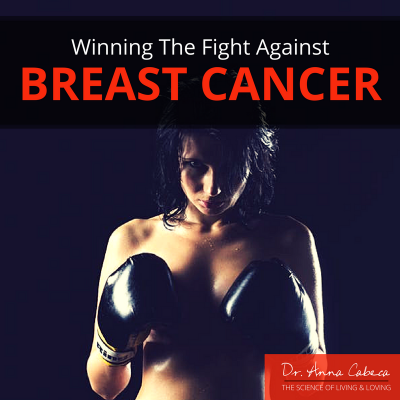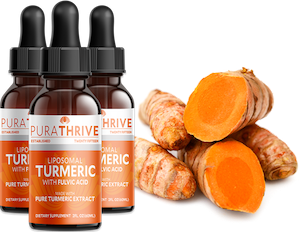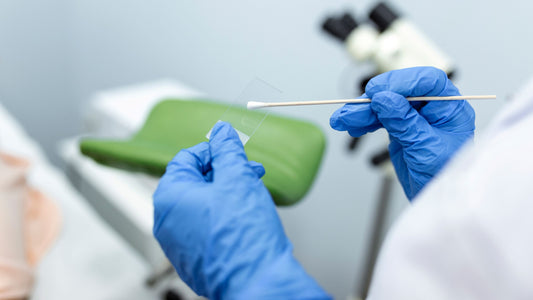All of us know someone who has battled with breast cancer, and many of you likely have done so yourself.
My family has been impacted as well and I know the pain of both the fight and the loss.

Any type of cancer is a terrible disease and it is my sincere hope and prayer that our most brilliant scientists and researchers will soon have a 100% cure!
In the meantime our focus needs to continue to be on maintaining our best health, keeping our inflammation under control and on educating ourselves about the preventive measures we and our loved ones can take to reduce our risks.
Especially having daughters this topic of "best breast health" is always on my mind and is an integral piece of my family's health routine.
This Article Will Review the Following Breast Cancer Prevention info:
- Understanding your risks - genetics, environment and lifestyle
- Reducing your overall inflammation: your number 1 priority!
- The importance of self-checks, doctor exams and testing
- Health tips that may reduce your risk!
- The importance of reading labels and using natural and toxin-free products
Understanding Your Risks
According to the CDC, other than skin cancer, breast cancer is the most common cancer among American women. And did you know that most breast cancers are found in women who are 50 years old or older?
So especially for those of us who have hit the big “50”…let’s be sure to do all that we can to reduce our ongoing risks. But for all of us know there are many things you can do each day - and annually - to help you avoid this terrible disease.
True, there is a genetic component to breast cancer, but please be clear that about 90% of your risk is due to environmental exposures and lifestyle decisions that YOU make!
So, you can totally influence that 90%!
In general, here is a brief overview of risk factors as we understand them today:
- Prior breast cancer: If you have ever had breast cancer, it is important to keep up with your examinations and recommended breast cancer detection screenings. Having had a breast biopsy that showed “lobular carcinoma insitu” and “atypical ductal hyperplasia” also puts you at higher risk.
- Genetics and family history: The lifetime risk of being diagnosed with invasive breast cancer is about one in eight for women, but is about two to three times greater for women with a history of breast cancer in a first-degree relative (mother, sister, or daughter) than in women with no family history of breast (or ovarian) cancer. About 9% of breast cancer can be attributed to a “family history” of breast cancer and fewer associated with a hereditary gene or germ cell mutation, i.e. the BRCA1 and BRCA2. There is a higher association between breast, ovarian, and colon cancers.
Your personal risk is increased by:
- having a mother, sister, or daughter with breast cancer,
- multiple generations of family members having been affected by breast or ovarian cancer,
- having relatives who were diagnosed with breast cancer at a young age (under 50 years old),
- having relatives who had both breasts affected by cancer;
- BRCA1 and or BRCA2 positive
- having dense breasts: dense breasts can make it hard to see tumors on a mammogram due to there being more connective tissue than fatty tissue.
Environmental and lifestyle factors:
- Smoking and second hand smoke
- Obesity, especially adult weight gain
- Alcohol usage
- Exposure to DDT and contaminants of pesticides (although this research has been inconsistent)
- Early menstrual period (women who start their periods before the age of 12 are exposed to hormones longer which raises the risk by a small amount)
- Older age of first child’s birth as well as never having a child
- Later menopause
- Prolonged hormone replacement therapy in menopausal women on Premarin and Provera has been shown to increase the risk by 8 per 10,000 women.
- Taking oral estrogen and progestin together for more than five years raises the risk for breast cancer
- Exposure to ionizing radiation
Reducing Your Body’s Overall Inflammation: Your Number 1 Priority!
Diet (aka nutrition!) and lifestyle choices can have a “positive effect” on reducing inflammation and on reducing your risk for breast cancer.
1. A Keto-Green® diet reduces inflammation (what and when you eat matter!)

Studies have confirmed that this dietary strategy is anti-inflammatory.
An alkaline diet has been linked with lower rates of cancer, cardiovascular disease and other chronic diseases. Animal and cell studies have shown that tumor growth actually increased in acidic environments and may support cancer proliferation.
In my Magic Menopause program I have seen diet changes that dramatically reduce inflammation. Participants eating an alkaline diet have reported less menstrual discomfort, less joint pain and reduced chronic pain due to inflammation (especially chronic back pain).
There have also been many studies which have scientifically shown that a ketosis state not only reduces overall inflammation and blood sugar issues (diabetes, insulin resistance), but that it may help fight cancer and may even be effective at treating diseases such as Alzheimer’s disease and Parkinson’s. As an aside, it can help you lose excess unhealthy weight as well.
When you eat matters, too.
Breast cancer risks may be reduced by implementing intermittent fasting (increasing the amount of time between dinner and breakfast; this diet strategy is a component of my Keto-Green Diet and Lifestyle) although scientists do not fully understand why this is so.
In one study the interval between dinner and breakfast had a significant impact to breast cancer risk. The interval of anything over 12.5 hours resulted in a significantly decreased risk over lower fasting intervals [1]
Theories relating to these findings include that intermittent fasting may improve gluco-regulation (improving your sensitivity to insulin and reducing insulin resistance) as well as improving your sleep (there is a lot of research indicating that getting less than 6 hours of sleep per night can cause ongoing low-grade inflammation which is linked to many diseases including breast cancer).
2. Natural treatments can also provide anti-inflammatory support and strengthen your immune system
Mighty Maca® Plus: Anti-inflammatory, alkalizing and detoxifying

I use Mighty Maca as a baseline protocol in all of my transformation programs, as I know that for true healing to occur, the lingering effects of years of inflammation need to be addressed.
As I researched and developed my Mighty Maca Plus drink one of my primary goals was to create a superfoods drink that would reduce inflammation. Key ingredients needed to provide anti-inflammatory benefits; so I included maca, turmeric, mangosteen, cat’s claw, resveratrol, and many more.
Turmeric: The perfect natural inflammation fighter!
Not only do I use turmeric in my Mighty Maca formula, but I love using it as an add-on inflammation fighter as well. Turmeric not only reduces existing inflammation but can stop your body from producing the chemicals that initiate inflammation in the first place. This is how aspirin and OTC pain meds work, but turmeric is much better.
A 2004 study published in the journal Oncogene found that components of turmeric were effective alternatives to the drugs aspirin, ibuprofen, sulindac, phenylbutazone, naproxen and diclofenac, to name a few [2].
Turmeric contains the component, curcumin, recognized as a wonderful natural cell protectant, antioxidant and anti-inflammatory.
It has been used for centuries in traditional Chinese herbal medicine and Ayurveda medicine. A number of laboratory studies relating to cancer cells have additionally shown that curcumin may have actual anticancer effects. It seems to be able to kill cancer cells and keep more from growing.
There has been a lot of research focused on curcumin. But did you know that turmeric itself is rich in many compounds beyond curcumin? It is, with curcumin being only one of turmeric's 199+ components. For that reason, I prefer using full-spectrum turmeric versus isolated curcumin extract.
I especially like to use the PuraTHRIVE® Organic Turmeric extract, a full-spectrum turmeric with high concentration and absorption.

Many turmeric supplements are poorly absorbed by your body, but PuraTHRIVE’s liposomal delivery system was designed to protect and deliver nutrients straight into the bloodstream (by protecting it from your body's digestive enzymes degrading its effectiveness!).
Other key supplements that I recommend for healthy breasts:
- Balance, a combination cream of natural progesterone and pregnenolone. These are our mother hormones and progesterone (bio-identical NOT synthetic) has been shown to support breast health and improve symptoms of fibrocystic breasts and estrogen dominance.
- OncoPlex containing sulforaphane glucosinolate, the protective and detoxifying phytochemical found in broccoli. It is a long lasting antioxidant and protects cells from free radical damage.
- Vitamin D/K2 combination to keep your serum Vit D 25 OH levels above 50. Certainly all women having had or having breast cancer need to be super proactive about their health. I highly recommend these women have a serum Vitamin D (25 OH) test and maintain a level of 80 in the blood.
- Melatonin supplement. Seriously, there is nothing better than a good night’s sleep to improve the body’s defense systems.
- Gut Thrive is a potent probiotic which supports intestinal health which supports immunity.
- Other great supplements would be Vitamin E and Vitamin C, and Omega-3s. These are powerful antioxidants that help your body fight off the “free radicals” that promote disease.
Preventative Focus is Vital: The Importance of Self-checks, Doctor Exams and Testing
Ultimately YOU are the champion of your own health which includes your breast (and all your lady parts!) health. Or if you are a man reading this, please provide support to the women in your life and encourage them to do their routine breast self-checks, doctor visits and screenings! Early detection is key.
Breast Self-Checks:
The first step to breast self-exam is always visual inspection.
Yes, this requires looking at your body naked in the mirror!

Step #1: Raise your hands above your head and look for any pulling or dimpling of the skin or inversion (pulling in) of the nipple. Look at any changes to skin color, redness, swelling, change in nipple direction, or a lump.
Step #2: Keep looking, now push your hands together over your head and then bring your arms down and push in at your waist using your chest muscles. This contracts the pectoral muscles. If a tumor is growing under the skin it will attach from the connective tissue over the muscle to the connective tissue under the skin. Let your doctor know if there is any change, dimpling, irregularity to the skin.
Step #3: While seated or standing in the shower (soapy wet skin makes it easier to feel), examine your breasts with one hand over your head, feel with the opposite hand above your clavicle and under your arm for any lumps, bumps, irregularities, tenderness, and note any discharge. It is best to use the soft pads of your three middle fingers and use soft, medium and deep pressure.
Be sure to examine the whole breast, from under the arm to the midline of your chest, then change sides and do it again. You can use a circular motion, up and down, left to right, it does not matter as long as you are consistent and do your exams the same way each time, and you will detect a difference should a problem occur.
Step #4: Finally lay down, take your time and repeat the breast exam as you did when standing.
Step #5: Report any abnormal findings to your doctor and follow up!
Physician Examinations
Your physician should examine your breasts annually and take you through the same steps as above, inspection, exam seated and lying. Any abnormalities are usually followed up with a mammogram, ultrasound, and or biopsy.
Your doctor may feel or see something you do not. Some patients have twice yearly or more frequent exams with their physician based on personal and family history.
Screenings (Mammograms, Ultrasounds, MRIs, Biopsies)
I know that screenings can be scary. Sometimes you can get false positives and may be called back and it can be very emotional. I also had scary moments during my mammogram, ultrasound and MRI several years ago. I was very nervous but wanted to share the experience thinking it might help others. Everything ended up fine, but please remember it is so important to do regular checks.
The American Cancer Society has established guidelines on screening mammograms. While mammograms do not prevent breast cancer, they can save lives by detecting early disease. Mammograms have been shown to lower the chance of dying from breast cancer by 35% in women over 50 years old.

We currently recommend a baseline mammogram at age 40 years old for women and then yearly after age 45 years old. Mammograms are not perfect however, and dense breast tissue can sometimes mask true disease.
If you are deemed to be at higher risk for breast cancer screening recommendations may be more frequent. Discuss with you doctor or you can also read the information on the Susan G. Komen website (and then discuss with your doctor!)
Most health insurance will cover the cost of routine mammograms and other required screenings. But there are many programs and services available throughout the country to help women defray the cost of their mammogram. You can do an online search, or one such service is provided by the National Breast Cancer Org by clicking here. Another informative page on affordability for screening services can be found on the Susan G. Komen website, here.
A final note on screenings.
Many doctors will send you a reminder for your annual exam and mammogram, but make a note of it yourself on your calendar...it is important!
The Importance of Reading Labels and Using Natural and Toxin-free Products
Get educated on endocrine disrupting products that you may use! Start by reading some articles on the Environmental Working Group website, EWG.org. There are a couple of great, easy-to-review lists there including foods known for containing the greatest amount of toxins…as well as info relating to endocrine disrupting chemicals found in skincare products and everyday cleaning products.
Important for anyone but especially important for women having had a history of breast cancer who need to be particularly diligent about anything – even natural products – that they put in or on their bodies.
When I was developing Julva®, my feminine restorative cream for the vulva, to address vaginal dryness, libido, pain and incontinence issues, one of the things I made sure of was that it was made from completely natural ingredients (each providing its own unique contribution to my overall formula). I had found that some lubricants and other vaginal moisturizing solutions out on the market actually contained endocrine disruptors! So scary considering we are putting these products on very sensitive and absorbent tissue.
I always recommend women discuss any new prescription, supplement or over-the-counter product with their primary care doctor. In the case of women having a previous breast cancer diagnosis and/or treatment, I strongly suggest women talk with their oncologists.
I make this same recommendation relating to the use of Julva as well although DHEA is the only ingredient in Julva that may concern women with breast cancer (because it is a bio-identical hormone and women may fear using a ‘hormone’). But DHEA is naturally secreted by the adrenal gland and ovary and is a very protective hormone with research indicating it is beneficial for brain health, bone health and breast health.
Please read the information here where I share with you some of the research which is very supportive of DHEA in regards to women having had breast cancer.
I have also posted some of the contraindications on that page relating to women having uncontrolled PCOS, women currently using Tamoxifen, women using Femara/Letrozole, and women who are concerned about the risk for blood clots.
Final Words on Taking Care of Those Breasts!
The American Cancer Society's estimates for breast cancer in the United States for 2017 are:
- About 252,710 new cases of invasive breast cancer will be diagnosed in women.
- About 63,410 new cases of carcinoma in situ (CIS) will be diagnosed (CIS is non-invasive and is the earliest form of breast cancer).
- About 40,610 women will die from breast cancer.
These numbers are scary, but we can improve our risk factors and detection is key!
Make sure you keep up on self-checks, routine doctor appointments and your mammograms.
So ladies, let’s take care of our bodies and our beautiful breasts!
References
[1] Nightly prolonged fasting (ketogenic lifestyle factor), greater than 13 hours also showed a decrease in breast cancer, a decrease in HbA1c and an increase in sleep. (JAMA Oncol. 2016 Aug 1;2(8):1049-55)
[2] Analgesic Efficacy and Safety of Curcuminoids in Clinical Practice: A Systematic Review and Meta-Analysis of Randomized Controlled Trials: Pain Med. 2015 Dec 14. Epub 2015 Dec 14. PMID: 26814259



